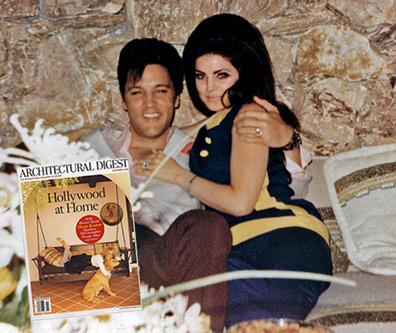Famous Presley Homes Featured Architectural Digest
October 28, 2008 | Other
Be sure to pick up a copy of the November 2008 edition of “Architectural Digest” to see a candid interview with Priscilla Presley about her life with Elvis at Graceland and their California homes.
The article:
By 1966 Elvis Presley’s film career was in the doldrums, a fact he recognized all too painfully. Told he would have to sing the children’s ditty “Old MacDonald” for the movie Double Trouble, the King is said to have cried out: “It’s come to this?” And in 1967 he began production on Girl Happy, where the most influential figure in the history of rock-and-roll was ultimately reduced to imploring us to “dig right in and do the clam”—a would-be dance craze that never really caught fire, strangely enough.
At the same time, paradoxically, his personal life couldn’t have been happier. In the wee hours of May 1, 1967, Elvis and his longtime love, Priscilla Beaulieu, slipped away to Las Vegas and were married in a very private ceremony at the Aladdin Hotel. They returned later that afternoon to the house they’d been renting on Ladera Circle in Palm Springs. Originally built by the prolific local developer Robert Alexander for his wife, the home comprised four large circles of glass and stone set high on a hill, overlooking the Coachella Valley. After Elvis carried his bride over the threshold, the house instantly became known as the Honeymoon Hideaway.
“That was our getaway house,” recalls Priscilla Presley. Both before and after the wedding, she says, the house on Ladera Circle served as a luxuriously secluded decompression chamber for Elvis, whose life in Los Angeles seemed like a never-ending series of film shoots, recording sessions and meetings. “Once we started driving into Palm Springs, there was a calmness that took over. I always loved that feeling; we really needed that at the time. We went almost every weekend, or whenever Elvis had lots of stress.” They often traveled there by limousine, she says, but sometimes he would drive whichever car was his favorite at the moment.
In Los Angeles the couple had lived for a while in the Bel-Air neighborhood—until obsessive fans figured out that they could park their cars on the dead-end street above the house and peer through the windows with binoculars. It was an adamant Priscilla Presley who drove over to Beverly Hills to scout out a more private location. She finally found one on Hillcrest Road, where she and her husband—and, very soon, their new daughter, Lisa Marie—resided whenever the demands of Elvis’s career required him to be in Los Angeles.
California was where Elvis worked, Priscilla Presley maintains. But Graceland—the Memphis mansion that most people will always think of as Elvis’s home—was where his heart lay. “Memphis was playtime,” she says. It was there that her husband could be himself: fun and relaxed, away from Hollywood pressures, ensconced safely in his beloved South, not far from his Mississippi birthplace. “He was truly a free spirit, and a kid at heart. We’d watch movies at all hours of the night, roller-skate, go to the fairgrounds, go on roller coaster rides. We’d race go-karts up and down the front drive. We’d play badminton in the summer and have snowball fights in the winter. These were his ways of relaxing.”
In the late 1960s Priscilla Presley was still in her early 20s and had already been coming to Graceland—and living there, off and on—for almost five years, ever since she’d entered the celebrity stratosphere as Elvis’s teenage girlfriend. To her, the fun and games that marked life at Graceland were nature, not nostalgia. “For me to adapt to that life, it wasn’t very difficult—I was still a kid! But when it came to work, that was a different ball game. Elvis was quite professional, did his job and did it well.”
Invariably, that meant returning to Los Angeles, where the cycle of film shoots, recording sessions and business meetings would begin anew. On weekends the Presleys would again escape to the Ladera Circle Honeymoon Hideaway—and later, to an Albert Frey house in the Chino Canyon section of Palm Springs that they purchased in 1970—but when they could, they went back to Graceland, which continued to be their preferred retreat until their marriage dissolved in 1972.
In 1979, two years after Elvis Presley’s death, Priscilla Presley, as his estate’s coexecutor, assumed control of Graceland. The house was costing the estate so much money that unless something dramatic was done, it would have to be sold. Even though her memories of life at Graceland were now laced with bittersweetness, Priscilla Presley couldn’t bear to let the house go. Then she had the idea of opening it to the public—an idea that not only saved the house but made it into a highly profitable venture.
“I wasn’t willing to lose it, so I just had to try something,” she says. “The alternative was unbearable. We had so many staff that still lived there and still maintained the home; they’d been with us for 20 years or more. I wanted to do what I felt Elvis would have wanted us to do, which was to save it. To keep it.” Today Graceland is the second-most-visited residence in America; only the White House can boast more visitors. And thus did the privacy-starved Presleys finally open up their home to millions of adoring fans from all over the world.
Source:EPE - Elvis Presley Enterprises
Ruthie wrote on
October 30, 2008
The magazine article is great. I am still drooling over the Palm Springs home.